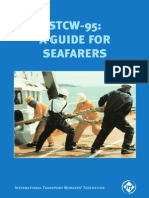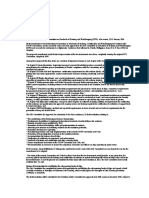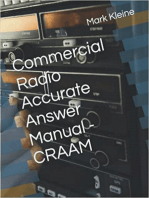0 ratings0% found this document useful (0 votes)
24 viewsSTCW
STCW
Uploaded by
sanadmustafa13The document outlines the standards of training, certification and watchkeeping for seafarers established by the 1978 STCW Convention. It discusses the major revisions made in 1995 to bring the Convention up to date. It also describes the regulations and mandatory requirements for training and qualifications of ship personnel covered in the Convention's chapters and regulations.
Copyright:
© All Rights Reserved
Available Formats
Download as PDF, TXT or read online from Scribd
STCW
STCW
Uploaded by
sanadmustafa130 ratings0% found this document useful (0 votes)
24 views5 pagesThe document outlines the standards of training, certification and watchkeeping for seafarers established by the 1978 STCW Convention. It discusses the major revisions made in 1995 to bring the Convention up to date. It also describes the regulations and mandatory requirements for training and qualifications of ship personnel covered in the Convention's chapters and regulations.
Original Description:
Stcw
Copyright
© © All Rights Reserved
Available Formats
PDF, TXT or read online from Scribd
Share this document
Did you find this document useful?
Is this content inappropriate?
The document outlines the standards of training, certification and watchkeeping for seafarers established by the 1978 STCW Convention. It discusses the major revisions made in 1995 to bring the Convention up to date. It also describes the regulations and mandatory requirements for training and qualifications of ship personnel covered in the Convention's chapters and regulations.
Copyright:
© All Rights Reserved
Available Formats
Download as PDF, TXT or read online from Scribd
Download as pdf or txt
0 ratings0% found this document useful (0 votes)
24 views5 pagesSTCW
STCW
Uploaded by
sanadmustafa13The document outlines the standards of training, certification and watchkeeping for seafarers established by the 1978 STCW Convention. It discusses the major revisions made in 1995 to bring the Convention up to date. It also describes the regulations and mandatory requirements for training and qualifications of ship personnel covered in the Convention's chapters and regulations.
Copyright:
© All Rights Reserved
Available Formats
Download as PDF, TXT or read online from Scribd
Download as pdf or txt
You are on page 1of 5
Standanders of training, Certification and
watchkeeping for seafarers
Introduction:
The 1978 STCW Convention was the first to establish basic
requirements on training, certification and watchkeeping for
seafarers on an international level. Previously the standards of
training, certification and watchkeeping of officers and ratings
were established by individual governments, usually without
reference to practices in other countries. As a result standards and
procedures varied widely, even though shipping is the most
international of all industries.
The Convention prescribes minimum standards relating to training,
certification and watchkeeping for seafarers which countries are
obliged to meet or exceed.
The 1995 amendments:
The 1995 amendments, adopted by a Conference, represented a
major revision of the Convention, in response to a recognized need
to bring the Convention up to date and to respond to critics who
pointed out the many vague phrases, such as "to the satisfaction of
the Administration", which resulted in different interpretations
being made.
Another major change was the requirement for Parties to the
Convention are required to provide detailed information to IMO
concerning administrative measures taken to ensure compliance
with the Convention.
The 1995 amendments entered into force on 1 February 1997.
STCW Code:
The regulations contained in the Convention are supported by
sections in the STCW Code. Generally speaking, the Convention
contains basic requirements which are then enlarged upon and
explained in the Code. Part A of the Code is mandatory. The
minimum standards of competence required for seagoing personnel
are given in detail in a series of tables. Part B of the Code contains
recommended guidance which is intended to help Parties
implement the Convention. The measures suggested are not
mandatory.
STCW Convention chapters and Regulations:
Chapter I: General provisions.
I. Regulation I/1 - Definitions and clarifications
II. Regulation I/2 - Certificates and endorsements
III. Regulation I/3 – Principles governing near-coastal voyages
IV. Regulation I/4- Control procedures
V. Regulation 1/5 - National provisions
VI. Regulation I/6 - Training and assessment
VII. Regulation I/7 - Communication of information
VIII. Regulation I/8 - Quality standards
IX. Regulation 1/9 - Medical standards
X. Regulation I/10 - Recognition of certificates
XI. Regulation I/11- Revalidation of certificates
XII. Regulation /12 - Use of simulators
XIII. Regulation 1/13 - Conduct of trials
XIV. Regulation I/14 - Responsibilities of companies
XV. Regulation I/15 - Transitional provisions.
Chapter II: Master and deck department.
I. Regulation 1/2 The mandatory minimum requirements for granting
certificates to officers responsible for navigational control on ships
of 500 gross tonnage or more.
II. Regulation 1/2 - mandatory minimum requirements to obtain
certification for the master and their master colleagues on vessels
of 500 gross tonnage or more.
III. Regulation 3/2 - the mandatory minimum requirements for
obtaining a certificate for the officers in charge of the marine
escort and the masters of ships with a gross tonnage of less than
500 tons on voyages close to the coast.
IV. Regulation 2/4 - Mandatory Minimum Requirements for
Approving Classifications That Are Part of Navigational Control
V. Regulation 2/5 - Mandatory Minimum Requirements for
Approving Classifications as Surface Capable Seafarers
Chapter III: Engine department.
I. Regulation III/1 - Mandatory minimum requirements for
certification of officers in charge of an engineering watch in a
manned engine-room or as designated duty engineers in a
periodically unmanned engine-room
II. Regulation I/2 Mandatory minimum requirements for certification
of chief engineer officers and second engineer officers on ships
powered by main propulsion machinery of 3000 kW propulsion
power or more. Regulation II/3 - Mandatory minimum
requirements for certification of chief engineer officers and second
engineer officers on ships powered by main propulsion machinery
of between 750 kW and 3000 kW propulsion power.
III. Regulation III/4- Mandatory minimum requirements for
certification of ratings forming part of a watch in a manned engine-
room or designated to perform duties in a periodically unmanned
engine-room. Regulation I/5 - Mandatory minimum requirements
for certification of ratings as able seafarer engine in a manned
engine-room or designated to perform duties in a periodically
unmanned engine-room. Regulation II/6- Mandatory minimum
requirements for certification of electro- technical officers.
IV. Regulation II/7 - Mandatory minimum requirements for
certification of electro- technical rating
Chapter IV: Radio communication and radio personnel.
I. Regulation IV/1 Application
II. Regulation IV/2 - Mandatory minimum requirements for
certification of GMDSS radio operators
Chapter V: Special training requirements for personnel on certain
types of ships.
I. Regulation V/1-1 - Mandatory minimum requirements for the
training and qualifications of masters, officers, and ratings on oil
and chemical tankers.
II. Regulation V/1-2 - Mandatory minimum requirements for the
training and qualifications of masters, officers, and ratings on
liquefied gas tankers.
III. Regulation V/2 - Mandatory minimum requirements for the
training and qualifications of masters, officers, and ratings and
other personnel on passenger ships.
Chapter VI: Emergency, occupational safety, medical care and
survival functions.
I. Regulation VI/1 Mandatory minimum requirements for safety
familiarization, basic training, and instruction for all seafarers.
II. Regulation VI/2 Mandatory minimum requirements for the issue of
certificates of proficiency in survival craft, rescue boats, and fast
rescue boats Regulation VI/3 - Mandatory minimum training in
advanced firefighting.
III. Regulation VI/4 - Mandatory minimum requirements related to
medical first aid and medical care.
IV. Regulation VI/5 - Mandatory minimum requirements for the issue
of certificates of proficiency for ship security officers.
V. Regulation VI/6 Mandatory minimum requirements for security-
related training and instruction for all seafarers.
Chapter VII: Alternative certification.
I. Regulation VII/1 - Issue of alternative certificates
II. Regulation VII/2- Certification of seafarers
III. Regulation VI/3 Principles governing the issue of alternative
certificates
Chapter VIII: Watchkeeping.
I. Regulation VIII/1 Fitness for duty
II. Regulation VI1/2 -Watch keeping arrangements and principles to
be observed
You might also like
- STCW 101 PresentationDocument73 pagesSTCW 101 PresentationNikkoJones100% (1)
- International Convention For The Safety of Life at Sea (SOLAS), 1974Document6 pagesInternational Convention For The Safety of Life at Sea (SOLAS), 1974Tata AlaniaNo ratings yet
- FAR/AIM 2021: Federal Aviation Regulations/Aeronautical Information ManualFrom EverandFAR/AIM 2021: Federal Aviation Regulations/Aeronautical Information ManualNo ratings yet
- STCW Structure: Standards of Training, Certification, and WatchkeepingDocument2 pagesSTCW Structure: Standards of Training, Certification, and WatchkeepingThe BlitzNo ratings yet
- Past Question Papers Theory Solved Jan 12 To Jan 15 Capt. Saujanya SinhaDocument282 pagesPast Question Papers Theory Solved Jan 12 To Jan 15 Capt. Saujanya Sinhabasheer shaik100% (2)
- FAR-AMT 2021: Federal Aviation Regulations for Aviation Maintenance TechniciansFrom EverandFAR-AMT 2021: Federal Aviation Regulations for Aviation Maintenance TechniciansRating: 5 out of 5 stars5/5 (2)
- Piloting, Seamanship and Small Boat Handling - Vol. VFrom EverandPiloting, Seamanship and Small Boat Handling - Vol. VRating: 5 out of 5 stars5/5 (2)
- STCW Code JakeDocument19 pagesSTCW Code Jakejake lavarejos100% (1)
- National Maritime Center: Standards of Training, Certification, and Watchkeeping (STCW) StructureDocument5 pagesNational Maritime Center: Standards of Training, Certification, and Watchkeeping (STCW) StructureAnthony Braye100% (1)
- LO4. STCW, MLC, ISM - PresentationDocument25 pagesLO4. STCW, MLC, ISM - PresentationBert Telesforo100% (4)
- STCWDocument37 pagesSTCWAbdul Hafiz80% (5)
- STCWDocument37 pagesSTCWAbdul HafizNo ratings yet
- STCW 2010 - Chapters & Manila AmendmentsDocument2 pagesSTCW 2010 - Chapters & Manila AmendmentsSanjith PrabhuNo ratings yet
- Activity 7 & 8 MGMT 2Document4 pagesActivity 7 & 8 MGMT 2Ramil SalundagaNo ratings yet
- 1 STCW OverviewDocument19 pages1 STCW OverviewJosh SebastianNo ratings yet
- 11 STCW ConventionDocument10 pages11 STCW Conventionmariners123No ratings yet
- STCWDocument30 pagesSTCWumutalidemirpolat50No ratings yet
- STCW Guide EnglishDocument78 pagesSTCW Guide EnglishANDREASBOUL100% (3)
- STCW Guide EnglishDocument78 pagesSTCW Guide EnglishBenja87100% (8)
- STCW Guide EnglishDocument78 pagesSTCW Guide EnglishOana ToganNo ratings yet
- STCW 95 Guide For SeafarersDocument88 pagesSTCW 95 Guide For SeafarersHung DinhNo ratings yet
- Isplaying The Only PostDocument2 pagesIsplaying The Only PostAnang Ma'rufNo ratings yet
- A10 11. MGMT 2 STCWDocument22 pagesA10 11. MGMT 2 STCWFrancis JeorgeNo ratings yet
- Enhancement of STCW ObjectivesDocument5 pagesEnhancement of STCW ObjectivessameerNo ratings yet
- STCW CodeDocument10 pagesSTCW CodeTo-trio Stouges100% (1)
- Marine Law Notes - 1Document16 pagesMarine Law Notes - 1Capt.Madan KumarNo ratings yet
- International Maritime Standards and National Maritime LegislationsDocument9 pagesInternational Maritime Standards and National Maritime LegislationsPiche Parcon Dayatan100% (1)
- Evaluasi PBMDocument94 pagesEvaluasi PBMJeppyJeffreezNo ratings yet
- D-1 02 The STCW Convention As Amended Rev-1Document50 pagesD-1 02 The STCW Convention As Amended Rev-1bimbimNo ratings yet
- STCW Guide English 01 January 2017Document78 pagesSTCW Guide English 01 January 2017662724100% (2)
- Standards and Regulations For Engine Watch KeepingDocument14 pagesStandards and Regulations For Engine Watch KeepingJustin CaliguiaNo ratings yet
- STCW 78 ConventionDocument35 pagesSTCW 78 Conventiondamlaozturk62No ratings yet
- Solas STCW SummaryDocument6 pagesSolas STCW SummarypraveenNo ratings yet
- Lo 2 STCW CodeDocument9 pagesLo 2 STCW CodeSamir WalavalkarNo ratings yet
- STCW'2010Document4 pagesSTCW'2010haidirNo ratings yet
- Adoption: 7 July 1978 Entry Into Force: 28 April 1984 Major Revisions in 1995 and 2010 (Latest Amendments AreDocument10 pagesAdoption: 7 July 1978 Entry Into Force: 28 April 1984 Major Revisions in 1995 and 2010 (Latest Amendments Aresukhjit78100% (1)
- MNGT 2 Week 12Document12 pagesMNGT 2 Week 12Jezel GringcoNo ratings yet
- MGMT 2 Week 9&10Document2 pagesMGMT 2 Week 9&10DarkxeiDNo ratings yet
- International Convention On Standards of Training, Certification and Watchkeeping For Seafarers, 1978Document11 pagesInternational Convention On Standards of Training, Certification and Watchkeeping For Seafarers, 1978rajishrrrNo ratings yet
- Day 1 International Obligation IMO Model Course 3.12Document27 pagesDay 1 International Obligation IMO Model Course 3.12tony ogbinar100% (2)
- stcw7 Circ24 Rev1Document4 pagesstcw7 Circ24 Rev1gongaxNo ratings yet
- Second Mates Maritime LawDocument64 pagesSecond Mates Maritime LawSudipta Kumar De100% (3)
- STCW 7-Circ 24Document4 pagesSTCW 7-Circ 24Evi Anastasiou100% (1)
- Revision of The STCW Convention: Latin American PanelDocument28 pagesRevision of The STCW Convention: Latin American PanelindumarnicaraguaNo ratings yet
- STCWDocument2 pagesSTCWNguyenTienDatNo ratings yet
- STCWDocument27 pagesSTCWOladokun Sulaiman Olanrewaju93% (14)
- STCW-95: A Guide For Seafarers: International Transport Workers FederationDocument88 pagesSTCW-95: A Guide For Seafarers: International Transport Workers Federationmingo622No ratings yet
- Marina SC 2021 05Document28 pagesMarina SC 2021 05Doni Richard SalazarNo ratings yet
- Transportation Law ProvisionsDocument17 pagesTransportation Law ProvisionsAya BeltranNo ratings yet
- 1.1 Overview STCWDocument39 pages1.1 Overview STCWmonica matualageNo ratings yet
- STCWDocument37 pagesSTCWJohn Mithu80% (5)
- Marine Radio Operator Permit Manual: Pass Your Marine Operator Permit ExamFrom EverandMarine Radio Operator Permit Manual: Pass Your Marine Operator Permit ExamNo ratings yet
- Navigation Rules and Regulations Handbook: International—InlandFrom EverandNavigation Rules and Regulations Handbook: International—InlandRating: 1 out of 5 stars1/5 (1)
- Regulatory Oversight of Ageing Management and Long Term Operation Programme of Nuclear Power PlantsFrom EverandRegulatory Oversight of Ageing Management and Long Term Operation Programme of Nuclear Power PlantsNo ratings yet
- FAR-AMT 2025: Federal Aviation Regulations for Aviation Maintenance TechniciansFrom EverandFAR-AMT 2025: Federal Aviation Regulations for Aviation Maintenance TechniciansNo ratings yet
- The Promise and The Potential of Digital Therapeutics DTX For DCDM 3hy96dDocument28 pagesThe Promise and The Potential of Digital Therapeutics DTX For DCDM 3hy96dNitin RoyNo ratings yet
- History: Wild AncestorsDocument2 pagesHistory: Wild AncestorspriyankaNo ratings yet
- Grade 11 - CP 4 Introduction To Problem SolvingDocument10 pagesGrade 11 - CP 4 Introduction To Problem Solvingkumar saiNo ratings yet
- Entrep 12 Marketing MixDocument14 pagesEntrep 12 Marketing MixZyrichNo ratings yet
- Electrical Concepts: Why SF6 Gas Used in HV/EHV Circuit Breaker?Document3 pagesElectrical Concepts: Why SF6 Gas Used in HV/EHV Circuit Breaker?Sureshraja9977No ratings yet
- PresentationsDocument1 pagePresentationsMadina SaparbaevaNo ratings yet
- Physics Experiment Report (Iv) Basic Physics "Oscillation Mathematics"Document8 pagesPhysics Experiment Report (Iv) Basic Physics "Oscillation Mathematics"JkanthNo ratings yet
- IEEE Transactions Power Apparatus and Systems, Vol. PAS-100, No. 2, February 1981Document8 pagesIEEE Transactions Power Apparatus and Systems, Vol. PAS-100, No. 2, February 1981Kevin Alexander Becerra SulcaNo ratings yet
- Chief Mate - Phase 1 - Cargo Handling and Stowage-18052011Document11 pagesChief Mate - Phase 1 - Cargo Handling and Stowage-18052011madhan01kumar0% (2)
- Amniotic Fluid Sludge Is Associated With Earlier Preterm Delivery and Raised Cervicovaginal Interleukin 8 ConcentrationsDocument7 pagesAmniotic Fluid Sludge Is Associated With Earlier Preterm Delivery and Raised Cervicovaginal Interleukin 8 ConcentrationsShinta Dewi WulandariNo ratings yet
- ACCT403 - Practice Questions On OverheadDocument3 pagesACCT403 - Practice Questions On OverheadElle Amoah BoaduNo ratings yet
- Quiz Exercises 9 Reported Speech 9Document2 pagesQuiz Exercises 9 Reported Speech 9Joséphine NancasseNo ratings yet
- Questionnaire SampleDocument2 pagesQuestionnaire SampleEkky CecilNo ratings yet
- Sew EurodriveDocument232 pagesSew EurodrivetujiohNo ratings yet
- G6 Revision Practice Sheet Final Exam Term-1Document6 pagesG6 Revision Practice Sheet Final Exam Term-1mennahNo ratings yet
- WEEK 12b - Berk DeMarzo-Chp 8Document81 pagesWEEK 12b - Berk DeMarzo-Chp 8Suzan BekçiNo ratings yet
- GR 257697Document7 pagesGR 257697Mae Frances R. AberinNo ratings yet
- Abhishek Sharma: B.TECH (Mechanical Engineering) +91-8005888188 Pitliya Bhawan, Amet, Rajsamand, Rajasthan Pin-313332Document2 pagesAbhishek Sharma: B.TECH (Mechanical Engineering) +91-8005888188 Pitliya Bhawan, Amet, Rajsamand, Rajasthan Pin-313332sanjeet giriNo ratings yet
- Mechanics: Classical Versus QuantumDocument11 pagesMechanics: Classical Versus QuantumJaneeshVargheseNo ratings yet
- Conexões de Barras Tubulares Com Chapa GussetDocument20 pagesConexões de Barras Tubulares Com Chapa GussetMarcosMirandaNo ratings yet
- 963Document50 pages963nanilNo ratings yet
- Akai s3000xlDocument313 pagesAkai s3000xlAnonymous stoudVe3rNNo ratings yet
- Sterner Infranor 872 & 876 Series Brochure 2005Document6 pagesSterner Infranor 872 & 876 Series Brochure 2005Alan MastersNo ratings yet
- Identi"cation of #Utter Derivatives of Bridge Decks: Ming Gu, Ruoxue Zhang, Haifan XiangDocument12 pagesIdenti"cation of #Utter Derivatives of Bridge Decks: Ming Gu, Ruoxue Zhang, Haifan XiangBuay BuayNo ratings yet
- Thomas Hood: Gnan Srishti School of ExcellenceDocument8 pagesThomas Hood: Gnan Srishti School of ExcellenceShazia ParveenNo ratings yet
- ch11 Human Endocrine System Vanders Human Physiology 15e Chap011Document38 pagesch11 Human Endocrine System Vanders Human Physiology 15e Chap011sueda123eybNo ratings yet
- Research Methodology Project-1Document19 pagesResearch Methodology Project-1sss0% (2)
- Phrasal Verbs - GrammarDocument24 pagesPhrasal Verbs - GrammarRosalba Bryan100% (2)
- PPTDocument38 pagesPPTLouis rajNo ratings yet
- ApacheHVAC User Guide - Virtual Environment - 6.1Document188 pagesApacheHVAC User Guide - Virtual Environment - 6.1leungNo ratings yet

























































































